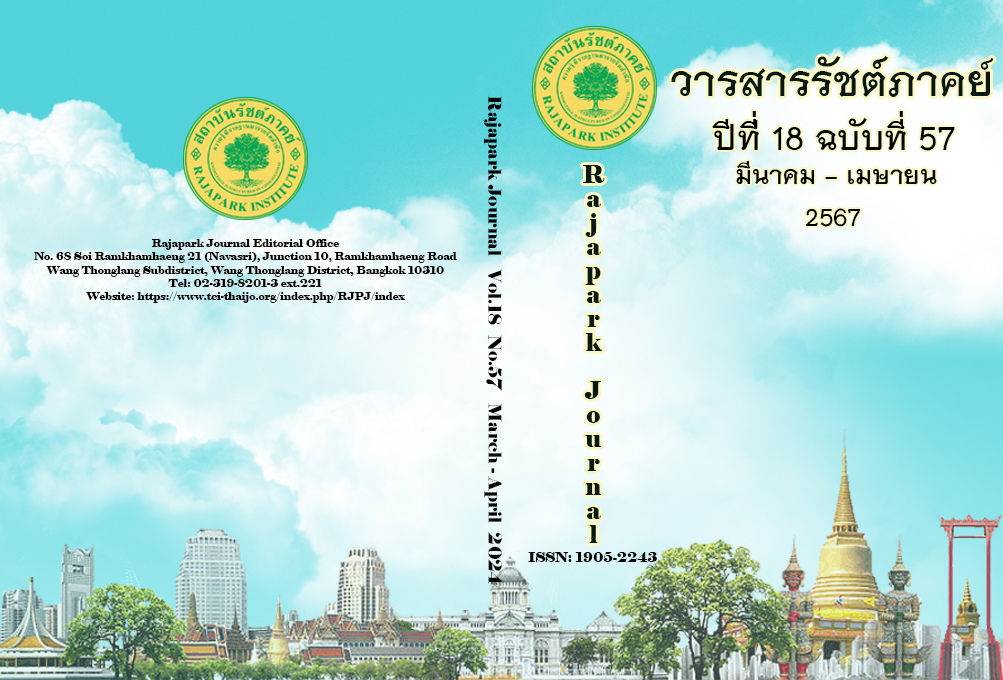Guidelines for Developing Destination Image in Wellness Tourism Spa Activities: A Case in Northern Thailand
Main Article Content
Abstract
The objectives of this research are 1) to study the perceptions of stakeholders in developing the image of health tourism in the form of spa activities. 2) Guidelines for developing the image of wellness tourism in the form of spa activities: a case study of northern Thailand. This research is a qualitative approach and utilizes qualitative data collection tools, including in-depth interviews with a sample group of 35 individuals and focus group discussions with a subgroup of 11 individuals who are stakeholders in wellness tourism related to activities in spas. The results of research objective 1 found that 1) image development in wellness tourism spa activities consists of 1) functional attributes are 1.1 The place that provides an authentic experience and a peaceful atmosphere. 1.2 The activities are varied, and the menu should be attractive. 1.3 The therapy room spa should have room for space, decoration, and cleanliness. 2) Human resources should have service quality, including service mind, expert spa therapy, and staff licenses. 3) A destination spa has unique characteristics that have local wisdom, way of life, and culture that are historically significant. 4) The wellness attributes a spa should have for well-being are physical, emotional, mental, and social. 5) Psychological attributes should be marketed online through social media to promote content related to health, safety, image, and trust. Objective 2: The research suggests guidelines for developing destination-image spa activities in wellness tourism. Identity and uniqueness should be using Lanna wisdom to communicate to customers the physical, mental, and spiritual spa therapy activities in order to be consistent with the needs of the customer group.
Article Details

This work is licensed under a Creative Commons Attribution-NonCommercial-NoDerivatives 4.0 International License.
Views and opinions appearing in the Journal it is the responsibility of the author of the article, and does not constitute the view and responsibility of the editorial team.
References
Abhicharttibutra, K., Kunnaviktikul, W., Thungjarealkul, P., WichaiKhum, O., Nantsupawat, A., & Wannapong, S. (2022). The Development of Spa Tourism Strategies to Be the Qualified Wellness Tourism Destination in the Corona Virus-2019 Pandemic Situation. Panyapawat Journal, 14(3), 41-58. https://so05.tci-thaijo.org/index.php/pimjournal/article/view/256695/176665
Ashton, A.S. (2014). Tourist Destination Brand Image Development—an Analysis Based on Stakeholders’ Perception: A Case Study from Southland, New Zealand. Journal of Vacation Marketing, 20(3), 279-292. https://doi.org/10.1177/1356766713518061
Bangkokbiznews. (2022, January 18). Spa Business Tends to Grown 17% per year After the Crisis of COVID-19. https://www.bangkokbiznews.com/social/983284
Baloglu, S., & McCleary, K.W. (1999). A Model of Destination Image Formation. Annals of Tourism Research, 26, 868-897. http://dx.doi.org/10.1016/S0160-7383(99)00030-4
Echtner, C.M., & Ritchie, J.R.B. (1993) The Measurement of Destination Image: An Empirical Assessment. Journal of Travel Research, 31, 3-13. http://dx.doi.org/10.1177/004728759303100402
Global Wellness Institute. (2018). Wellness Now a $4.2 Trillion Global Industry – with 12.8% Growth from 2015-2017. https://globalwellnessinstitute.org/global- wellness-institute-blog/2018/10/06/wellness-now-a-4-2-trillion-global-industry/
Global Wellness Institute. (2023). Wellness Tourism. https://globalwellnessinstitute.org/what-is-wellness/what-is-wellness-tourism/
Klunpakdee, P., Sangpikul, A., & Kumsupron, S. (2020). Thai World Class Spa Business Development in Thailand towards Sustainability. Journal of Health Science of Thailand, 29(6), 1147–1156. https://thaidj.org/index.php/JHS/article/view/9621
Laing, J. H., Voight, C., Wray, M., Brown, G., Weiler, B., Howat, G., & Tremath, R. (2010). Sand, Surf, Spa and Spirituality? Examination of a Scoping Study of Medical and Wellness Tourism in Australia. Travel and Tourism Research Association.
Ministry of Tourism and Sports, Thailand. (2022). The 3rd National Tourism Development Plan (2023 - 2027). https://anyflip.com/zzfck/rptc/
Office of the National Economic and Social Development Council. (2022, November 15). Goals and Guidelines Develop the Region 2023 – 2027. https://www.nesdc.go.th/ewt_dl_link.php?nid=13225
Prachachat. (2023, December 16). Domestic Economy. https://www.prachachat.net/economy /news-1458097
Prommaha, J. (2019). Guidelines for Identity Development and Image Perception of Thai Brand in Health and Wellness Tourism. Journal of Thai Hospitality & Tourism, 14(2), 77-90. https://so04.tci-thaijo.org/index.php/tourismtaat/article/view/206976
Sheldon, P. J., & Bushell, R. (2009). Introduction to Wellness and Tourism. In R. Bushell & P. J. Sheldon (Eds.), Wellness and Tourism: Mind, Body, Spirit, Place (pp. 3-18). Cognizant Communication Corporation.
Smith, M., & Puczkó, L. (2014). Health, Tourism and Hospitality: Spas, Wellness and Medical Travel. Routledge.
The International Spa Association (ISPA). (2013). Type of Spa. https://experienceispa.com/resources/spa-goers


